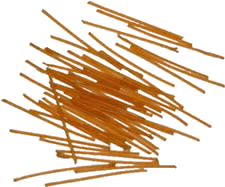Home | Glossary | Resources | Help | Contact Us | Course Map
Archival Notice
This is an archive page that is no longer being updated. It may contain outdated information and links may no longer function as originally intended.
Modern Propellants
To avoid the shortcomings of black powder, researchers had to consider propellant chemicals that incorporated oxidizers rather than inorganic materials that contribute corrosive by-products. Eliminating sulfur from the material was important for the same reason. The quest for reduced smoke meant that higher combustion temperatures would be required. Most importantly, the new propellant had to be controllable and reproducible to be safe.
Nitrocellulose
In 1845-46, a substance was invented that showed promise. Nitrocellulose was the result of treating common cotton fibers (containing cellulose) with nitric acid. This reaction adds nitrogen and oxygen to cellulose molecules. The nitration process is performed in the presence of sulfuric acid to scavenge extra water generated by the reaction and allows the attachment of the maximum number of nitrate radicals to permit better combustion.
When burned, the added oxygen in the nitrate radicals allows full involvement of the fuels in cotton, releasing significantly more energy than untreated cellulose. This produces a large volume of gas and leaves minimal visible solid by-products. In contrast, black powder would produce smoke and fouling.
Although this development gave chemists the self-contained oxidizer and minimal residue, guncotton could not be predictably controlled in its native state. Its combustion could prove too violent for iron gun systems of that period; numerous accidents were attributed to the attempts to manufacture it for propellant use.
| Note: |
| Captain Schultze of the Prussian Artillery attempted to use treated wood cellulose rather than cotton to control combustion. His efforts showed some progress for small-arms propellants, but not enough to reduce the burning rate to the degree required for cannons. |
Celluloid
The solubility of guncotton in a mixture of alcohol and ether was discovered a year after nitrocellulose was developed. Dissolved nitrocellulose (celluloid) was used as one of the first plastics. Initially, this critical step in the development of smokeless propellant was used only for coating photographic plates and making consumer items that once had to be carved from tortoise shell or ivory.
See the YouTube Terms of Service and Google Privacy Policy
Plasticizer
Twenty years later (1884), Paul Vielle, a chemist working for the French government, experimented with the alcohol/ether solubility of nitrocellulose. He formed the wet mass into thin layers and partially dried them into flexible sheets. The residual alcohol/ether mixture acted as a plasticizer that helped prevent the granules from shattering. Cut into small flakes, the material burned inward from the surface. This property meant that the volume of gas produced decreased as the burning granules became smaller, which is a useful characteristic in propellants. Changing the dimensions of the granules resulted in different rates of energy release. Vielles discovery opened the door to modern propellants. His work was so effective that cut-sheet propellants are in limited use today.
A major disadvantage of Vielles method was dehydration. If the alcohol/ether plasticizer evaporates in storage, the rate of energy release increases. Dry granules could also break into smaller pieces, increasing surface area and thus the release rate.
Nitroglycerin
The discovery of dynamite in 1887 by Alfred Nobel allowed nitroglycerin to be used as a high explosive. He found that he could blend nitroglycerin with less-nitrated nitrocellulose to form a colloidal mass similar to that used to make Vielles nitrocellulose. Nitroglycerin served as the plasticizer and added significant energy to the mix. When well mixed with nitrocellulose, the usually unforgiving nitroglycerin was stable, allowing the formation of clean-burning grains without the use of any additional solvents.
Cordite
In a race to develop a smokeless powder, the British government commissioned a research group. Their solution was to mix acetone, nitrocellulose, nitroglycerin, and petroleum jelly to form a colloid. After evaporating the acetone solvent, the material could be extruded into long, cylindrical cords. In 1889, the resulting end product was named Cordite.
Vielles smokeless propellant, with nitrocellulose as the sole storehouse of energy, became known as single-base propellant. Nobels invention (which he named Ballistite) and the British Cordite, with their dual energy sources, became known as double-base propellants. Both single-base and double-base types are still in use today.
Smokeless propellants still retain the base ingredients used in the 1880s. However, knowledge of granule control, deterrent coatings, and safe processing has produced ammunition suitable for a wide range of uses from the smallest rimfire cartridges to massive naval guns.
Additional Online Courses
- What Every First Responding Officer Should Know About DNA Evidence
- Collecting DNA Evidence at Property Crime Scenes
- DNA – A Prosecutor’s Practice Notebook
- Crime Scene and DNA Basics
- Laboratory Safety Programs
- DNA Amplification
- Population Genetics and Statistics
- Non-STR DNA Markers: SNPs, Y-STRs, LCN and mtDNA
- Firearms Examiner Training
- Forensic DNA Education for Law Enforcement Decisionmakers
- What Every Investigator and Evidence Technician Should Know About DNA Evidence
- Principles of Forensic DNA for Officers of the Court
- Law 101: Legal Guide for the Forensic Expert
- Laboratory Orientation and Testing of Body Fluids and Tissues
- DNA Extraction and Quantitation
- STR Data Analysis and Interpretation
- Communication Skills, Report Writing, and Courtroom Testimony
- Español for Law Enforcement
- Amplified DNA Product Separation for Forensic Analysts


